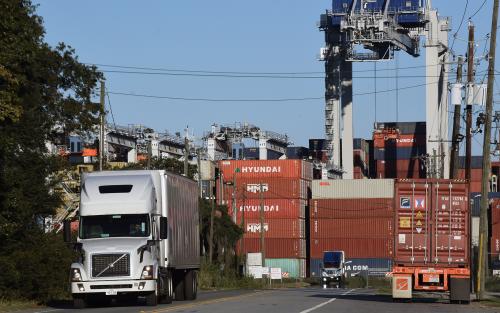How many new immigrants are there?
Earlier this year, the Congressional Budget Office (CBO) released estimates suggesting that net immigration—inflows minus outflows—was 3.3 million in 2023. That is much higher than the 1 million or so they projected pre-pandemic for 2023, which was a more typical figure for the 2010s. There is also some uncertainty about the 3.3 million number, which is higher than the most recent Census estimate of 1.1 million net migrants for the year ending July 2023. (See here for a more detailed explanation of why the CBO number seems reasonable.) Here we discuss the new immigrants: how they are arriving to the United States, what we know about them, and the economic implications of larger inflows.
What pathways are the new immigrants using to come to the United States?
Green Cards/Permanent Residents
One set of immigrants includes those entering into the lawful permanent migration category, often known as green card migration. Most green card migration is subject to annual caps set by Congress that were last updated in 1990. Immediate relatives (parents, spouses, and children) of U.S. citizens are eligible for green cards without caps, but other family members face annual limits, country-specific restrictions, and long queues for some applicants. For example, Mexican nationals with a U.S. citizen sibling who are receiving their green card in 2024 first submitted paperwork in 2001. Employers can also sponsor green cards for employees—this process is also subject to caps as well as limits on how many applications can be processed from any given country of origin. Often, employment-based green cards are issued to those who have been living and working in the U.S. on a temporary employment visa.
In total, about 1 million to 1.2 million new green cards are issued annually, though numbers were significantly lower in 2020 and 2021. Green cards are issued to immigrants from a wide range of countries, with about half of new permanent residents coming from the Americas and much of the remainder coming from Asian nations. About half of the roughly 1.1 million people acquiring green cards in 2023 were already in the U.S., and roughly 550,000 are new immigrants.
Regular Temporary Visas
There are also substantial numbers of immigrants who arrive every year on regular temporary visas including employment visas and student visas. The employment visas include those in the H-1B category, often tech sector workers who will eventually end up obtaining a green card. Employment visas also include the H-2A and H-2B visas which are for temporary or seasonal work, and typically filled by workers with less education who are required to return home when the visa expires. The H-2A program for agricultural workers has expanded in recent years. A typical year sees about 800,000 employment visas1 in major categories, with visa holders most commonly originating from India, Mexico, and China.
There are also nearly half a million students granted a student visa in a typical year. Students coming to the United States on visas most commonly originate from India, China, and South Korea.
In 2023, there were almost 1.8 million employment and student visas issued. But there were also a significant number of people exiting this category—either because they left the U.S., because their visa expired, or because they transitioned to a permanent status. Data on exits is incomplete, but CBO estimates net migration into this category overall to be 90,000, similar to recent years.
In 2023, the number of immigrants entering permanent residency or regular temporary status was not unexpected. The unusual part of the influx is a third category—those with neither permanent residence nor a regular temporary visa—which encompasses a range of situations and statuses.
Other migrants: Entries with inspection
Immigrants arriving without an entry visa are typically stopped with an “encounter” on the border between ports of entry or at a port of entry. In some cases, immigrants may have been trying to enter surreptitiously. Recently, however, a majority present themselves to an officer and often make an asylum claim. This may include, for example, migrants who use the official CBP One app to schedule an appointment at a port of entry, or those who cross between ports of entry. This recent type of border activity requires a different set of tools and resources than that of an earlier era when the primary orientation was intercepting undocumented migrants.
The number of asylum-seekers arriving at the border has grown in the past few years as conditions worsen in many countries. The strong American economy and comparatively pro-immigrant administration are also draws. Despite some recent attempts to create alternatives, asylum-seekers generally must present themselves on U.S. soil to make a claim, which the U.S. in turn is obligated to consider under international law. Between March 2020 and May 2023, authorities used public health emergency authority (Title 42) to turn back migrants without considering claims, but that authority has ended. Immigrants who claim they have fear of returning to their home country are given a short interview to assess whether this claim has credibility. After an initial screen, the migrant may be immediately removed from the United States, but more often is “paroled” into the country and/or given a “notice to appear” in immigration court, where they can petition for asylum or other relief from deportation.
A June 2024 executive order has made it much harder to seek asylum, resulting in more migrants being sent back to Mexico or their country of origin. There has been a sharp decline in arrivals at the border this summer. Migration to the border typically increases in the fall as temperatures cool, and it remains to be seen what will unfold in the coming months.
Immigrants may also enter the U.S. through several country-specific humanitarian parole programs which have been created by the Biden administration. Historically, humanitarian parole has been used on a smaller scale to meet more idiosyncratic needs. The current administration has issued parole to more than 115,000 Afghans and 170,000 Ukrainians. In addition, in part to address unmanageable border flows, it implemented the CHNV program Colombia, Haiti, Nicaragua and Venezuela. This has indeed encouraged some residents of these countries to avoid a dangerous trek to the Southern border by flying to the U.S. or waiting for an opportunity to do so. Once in the United States, participants have the opportunity to obtain a work permit and to apply to stay in the United States permanently, though their future in the United States is far from certain.
This group of “other” immigrants is sometimes mistakenly referred to as “illegal” or “undocumented” immigrants, but these terms are misnomers—the individuals are known to authorities, who have screened them and exercised their discretion to allow them into the country. They do not, however, have an official immigration “admission” nor long-run run certainty about their situation in the United States. About half of asylum claims are denied in court, at which point these migrants will be subject to deportation. In the meantime, they are sometimes referred to as having “twilight status”. About 2 million people entered the U.S. in 2023 in this way after encountering a border official.2
An encounter is recorded when an official interacts with a migrant at a port of entry or between ports of entry. The same person attempting entry multiple times would count as multiple encounters. (This scenario was more common during the Title 42 era ending in May 2023, when migrants were turned back without being able to make a case but often tried again.) Some encounters end in a person being removed (deported) or withdrawing their attempt at entry, so do not translate into new migration. The encounters statistics are helpful for understanding the demands on border operations, but less helpful for measuring inflows. We can see in the Southern border encounter disposition data, however, how many immigrants were permitted to enter through the categories above.
Other migrants: Unauthorized migration
The past few years have also seen an increase in the number of migrants surreptitiously crossing the Southern border without encountering a border official. The number of these so-called “entries without inspection” is inherently hard to measure, and the Department of Homeland Security (DHS) has not released recent estimates. The Secretary of Homeland Security testified that the agency had unofficially estimated 600,000 in FY 2022, and the number for FY 2023 may well be higher.
Another significant group entering the unauthorized population may have overstayed a temporary visa—the most recent visa overstay reports published by DHS suggests this number could be as high as 853,000, but it is important to note that measurement of exits is poor and this number may be overstated.
CBO estimates the 2023 net inflow into the undocumented category may be close to a million including those who entered without permission or overstayed a visa, but it is important to recognize a high degree of uncertainty around this number.
Demographic Characteristics
Immigrants who arrived in 2021 and 2022 were largely of working age, with 76.4% falling within the 16-64 age bracket, while the remaining populace primarily consisted of children. With a median age of 28, a significant proportion of these newcomers are likely to participate in the labor force for years to come. Notably, a majority of recent adult immigrants possess at least a high school diploma, with many holding a bachelor’s degree or higher; merely 18.7% have less than a high school education. Geographically, the new immigrants predominantly originate from South and Central America and the Caribbean, with nearly half of recent immigrants hailing from this region. The top three countries of origin were Mexico (13.19%), India (9.6%), and China (4.99%). Significant populations also came from Venezuela, Honduras, Guatemala, and Cuba. Other notable countries with high numbers of recent immigrants were Afghanistan, because of Operation Allies Welcome, and Ukraine, because of Operation Uniting Ukraine.
Summing Up
2023 was an atypical year for migration. Immigration more than caught up from the slow-down of 2020 and 2021, with unexpectedly high numbers of arrivals in twilight status categories. Inflows have declined this summer, and it seems likely that there will be lower numbers of migrants coming to the U.S. in 2024 than there were in 2023.
Economic implications
Policymakers are understandably concerned about effects on the employment prospects and wages of the U.S.-born, but economic studies reject the notion that immigrants take jobs away from Americans. In most contexts, it appears that immigrants create labor demand as well as supply, and that the typical U.S-born worker is not harmed. Recent arrivals have stressed the capacities of some local governments, however.
There is a long-standing economics literature that overwhelmingly suggests that immigration is beneficial for long run economic growth and innovation. Immigration will be increasingly important as the U.S. continues to face an aging population, declining fertility, and insolvency of the Social Security and Medicare systems. Ultimately, it will be up to Congress to expand legal pathways for the millions of people around the world who wish to contribute to the American economy.
-
Acknowledgements and disclosures
The Brookings Institution is financed through the support of a diverse array of foundations, corporations, governments, individuals, as well as an endowment. A list of donors can be found in our annual reports published online here. The findings, interpretations, and conclusions in this report are solely those of its author(s) and are not influenced by any donation.
-
Footnotes
- The 800,000 employment visas includes the following visa categories: CW (Common Wealth of Northern Mariana Islands transitional workers and their dependents); H (all H visas, including H4 for dependents); O (extraordinary ability and dependents); P (athletes, entertainers, and dependents); R (religious workers and dependents); TD/TN (NAFTA/USMCA workers and dependents); L (intracompany transferees and dependents); E (treaty traders, Australian specialty workers, and dependents); I (foreign information media representatives and dependents).
- An encounter is recorded when an official interacts with a migrant at a port of entry or between ports of entry. The same person attempting entry multiple times would count as multiple encounters. (This scenario was more common during the Title 42-era ending in May 2023, when migrants were turned back without being able to make a case but often tried again.) Some encounters end in a person being removed (deported) or withdrawing their attempt at entry, so do not translate into new migration. The encounters statistics are helpful for understanding the demands on border operations, but less helpful for measuring inflows. We can see in the Southern border encounter disposition data, however, how many immigrants were permitted to enter through the categories above.







Commentary
Who are the new immigrants?
September 11, 2024